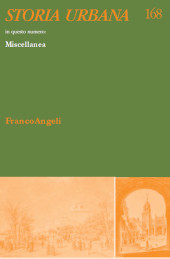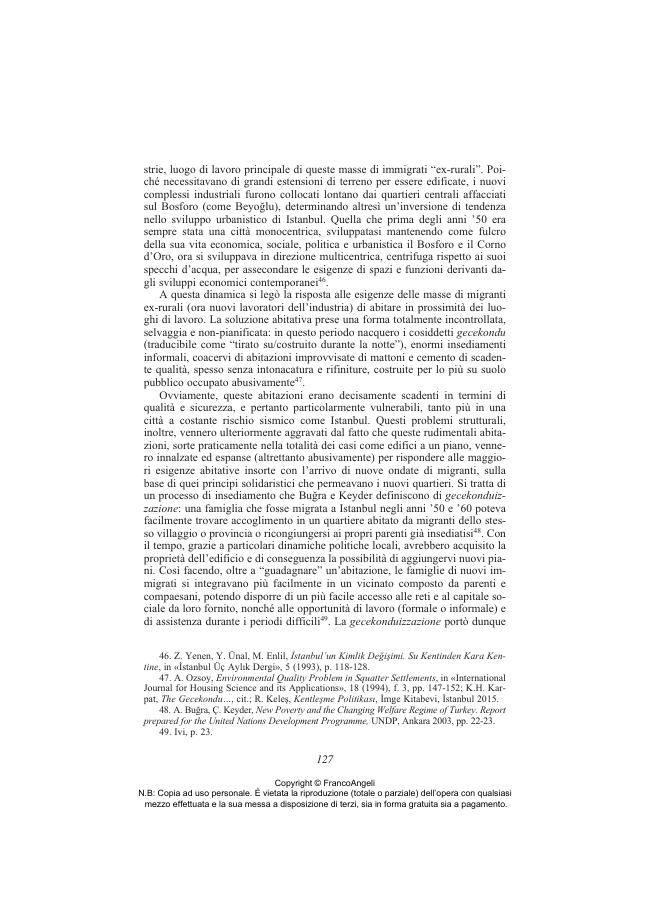L'impatto delle vicende economiche e politiche sulla trasformazione urbana e sociale di Istanbul (1923-1984)
115-139 p.
Istanbul, con i suoi oltre 16 milioni di abitanti, è oggi la maggiore città della Turchia e una delle megalopoli più grandi del mondo. Storica capitale dell'Impero Ottomano, oggi non è solo il maggiore centro abitato della Turchia, ma anche il suo cuore pulsante culturale, sociale ed economico. Da sola, la città genera oltre il 40% del gettito fiscale e circa il 40% del PIL della Turchia, con più del 20% della produzione industriale del Paese. Eppure, appena sessant'anni fa Istanbul era una città portuale stagnante e dimenticata, tagliata fuori dalle rotte del commercio internazionale, con meno di un milione di abitanti e una crescita praticamente nulla. La situazione di Istanbul rispecchiava la condizione della Turchia del secondo dopoguerra: un Paese scarsamente industrializzato e prevalentemente rurale, con strutture economiche basate principalmente sul settore agricolo, infrastrutture scarse e arretrate, poco integrato nel mercato internazionale.
In seguito la Turchia fu protagonista di una crescita vorticosa che, seppure caratterizzata da un andamento estremamente altalenante, la proiettò saldamente all'interno dei meccanismi del mercato globale negli ultimi due decenni del XX secolo. Questi processi scossero profondamente Istanbul e l'intero Paese, attraversati da enormi cambiamenti nelle dinamiche non solo economiche, ma anche politiche e sociali. La città fu protagonista di un pluridecennale processo di trasformazione che la portò da poco più di 950 mila abitanti nel 1950 a una metropoli con oltre 8 milioni di abitanti negli anni Novanta. L'articolo analizza come questi processi storici abbiano modificato la struttura economica, sociale, demografica di Istanbul, ponendo le basi per farla diventare la città che è oggi. [Testo dell'editore].
Istanbul, with a population of over 16 million, is the most important city of Turkey and one of the biggest metropolises of the world. Formerly capital of the Ottoman Empire, nowadays it is the major city of Turkey and its cultural, economic and social beating heart. The city alone generates over 40% of the tax revenue, about 40% of the entire nation's GDP, and more than 20% of the country's industrial production1. Strange as it may seem, less than sixty years ago Istanbul was a stagnant and forgotten port city, cut off from international trade routes, with less than a million inhabitants and virtually no growth2. Its condition mirrored the situation that the entire nation was living during the postwar period: a poorly industrialized and predominantly rural country, with economic structures mainly based on agriculture, poor and backward infrastructures, and generally far from being integrated in the international market.
Turkey will be capable of realizing a huge period of growth that albeit extremely unstable will bring it firmly within the mechanisms of the global market by the last two decades of the 20th century. These processes had a tremendous impact: Istanbul, as the entire nation did, was crossed by huge transformations not only in its economic dynamics, but also in political and social ones. The city was shaken by a decadeslong process of metamorphosis that took it from being just a big city among others, with its 950 thousand inhabitants in the Fifties, to becoming a huge metropolis of 8 million inhabitants by the Nineties3. The article will focus on how these historical processes have changed the economic, social, demographic structure of Istanbul, laying the foundations for making it the city it is today. [Publisher's text].
Forma parte de
Storia urbana : rivista di studi sulle trasformazioni della città e del territorio in età moderna : 168, 1, 2021-
Artículos del mismo número (disponibles individualmente)
-
Información
Código DOI: 10.3280/SU2021-168005
ISSN: 1972-5523
MATERIAS
KEYWORDS
- Turchia Istanbul Urbanizzazione Gecekondu Sviluppo urbano Comunità
- Turkey, Istanbul, Urbanization, Gecekondu, Urban development, Communities



